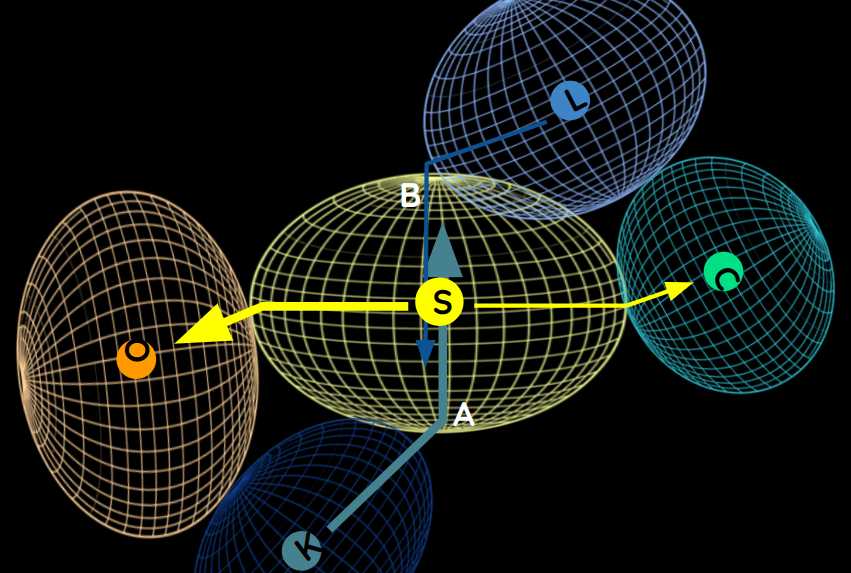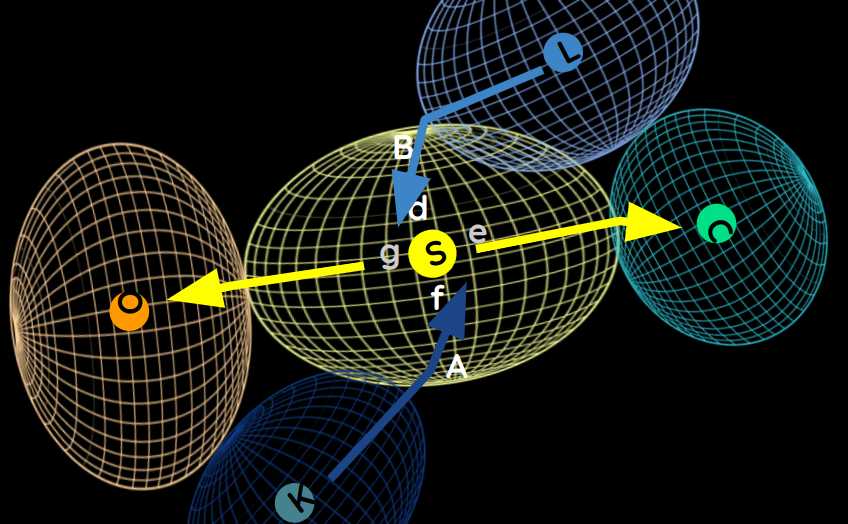The Nature of the Sun
Table of Contents
72. How the fire-aether that composes the Sun moves.
How does it move in the space defg?
- The part of it that comes from
Atravels straight tod- There it encounters the air-aether globules that propel it towards
B.
- There it encounters the air-aether globules that propel it towards
- The part that comes from
Btravels straight tof- There it encounters the air-aether globules, which propel towards
A.
- There it encounters the air-aether globules, which propel towards

Immediately, both the part that is at d and the part that is at f reflect in all directions towards the disk eg, pushing all the surrounding air-aether globules equally.
Finally, it escapes through the passages between these globules around the disk eg, towards M and Y.
The fire-aether moves straight from A towards d and from B towards f using its own motion.
But it also moves circularly by the motion of the whole vortex around the axis AB so that each of its particles describes spiral lines, twisted as a helix.
These spirals, when they reach d and f, reflect from there in both directions towards the disk eg.
The space defg is larger than the passages through which the fire-aether enters or exits.
- This is why some fire-aether always remains there.
- They form a very fluid body that perpetually rotates around the axis
fd.
73. Various inequalities in the position of the Sun’s body.
This body must be spherical.
The vortices are all unequal.
- Not an equal amount of fire-aether from the nearby vortices is supplied towards
Sthrough both poles. - The vortices
LandKare not positioned to send that fire-aether into directly opposite parts of the sun.
- The vortices
CandOdo not have the same diameter to admit the fire-aether exiting from the sun with equal ease.
These inequalities contribute to variations in the position, motion, and quantity of the fire-aether in the sun.
- But they do not change the sun’s shape.
For instance, assume that the force of the fire-aether coming from pole A towards S is greater than that coming from pole B.

This will make the A-based-fire-aether advance further towards B than the B-based-fire-aether advances towards A.
- But by advancing further, the force of the A-based-fire-aether will diminish.
According to the laws of nature, both will eventually repel each other where their forces are completely equal.
- This location of equality is where the sun’s body will be.
- Therefore, this will move the sun to be farther from pole A.
But this inequality will not make the sun less round.
- This is because the air-aether globules will not be repelled with greater force in part
dof its circumference than in partf.
Likewise, if the fire-aether exits more easily from S towards O than towards C (finding more free space there), the body S will move somewhat towards O.
- By reducing the space in between, they will finally be positioned where the force is equal on both sides.
Assume there are only 4 vortices L, C, K, O, all unequal. then the Sun S should neither be:
- in the middle space between
OandCnor - in the middle between
LandK.
Having more vortices around it will cause an even greater inequality.
74. Various irregularities in the motion of its fire-aether.
The fire-aether coming from the vortices K and L does not move towards S in as straight lines as towards some other parts.
All of the sun’s fire-aether rotates around pole fd.
The external fire-aether has 2 sources:
- the part coming from
Kthat moves towardse - the part from
Lthat moves towardsg

These will cause the poles fd to tilt:
- The pole
fwill tilt more towardse
- The northern pole
dwill tilt towardsg.
The sun’s fire-aether most easily exits from S:
- towards
Cvia straight lineSM - towards
Ovia straight lineSY
This will cause the Sun’s ecliptic eg:
- to tilt a bit more from
etowards poledthan towards polef, but not as much as the straight lineSM. - to tilt a bit more from
gtowards polefthan towards poled, but also not as much as the straight lineSY.
Hence, the axis fd around which the Sun’s fire-aether rotates, will be somewhat bent.
The fire-aether will rotate slightly faster between e and d, or between f and g, than between e and f, or d and g.
Perhaps it will not rotate with completely equal speed between e and d, and between f and g.
75. These irregularities do not prevent it from being round.
This, however, cannot prevent the body from being nearly round. This is because its other motion from the poles towards the ecliptic, compensates for these irregularities.
This is the same as a glass flask becoming round solely because air is introduced into its molten matter through a metal tube by fire.
- This air moves with the same force from the flask’s opening to its bottom and all other directions, pushing all those parts equally easily.
Likewise, the fire-aether enters the Sun’s body through its poles.
- It repels all the surrounding air-aether globules equally on all sides.
- It repels equally those air-aether into which it is only obliquely reflected and those which it directly strikes.